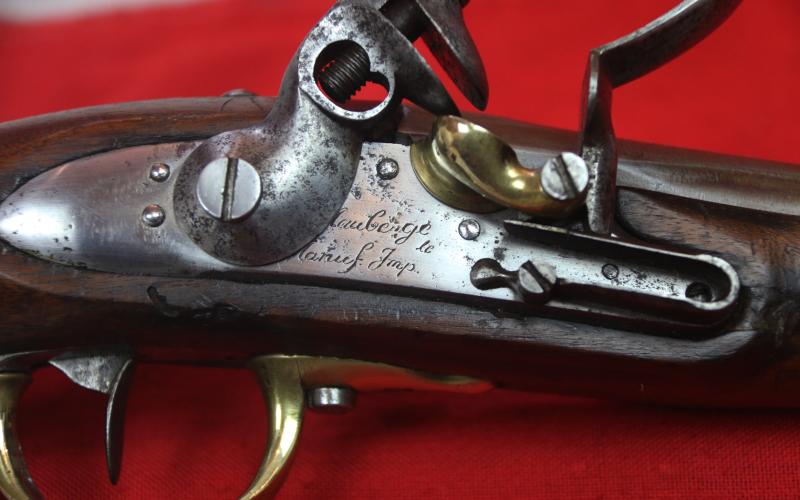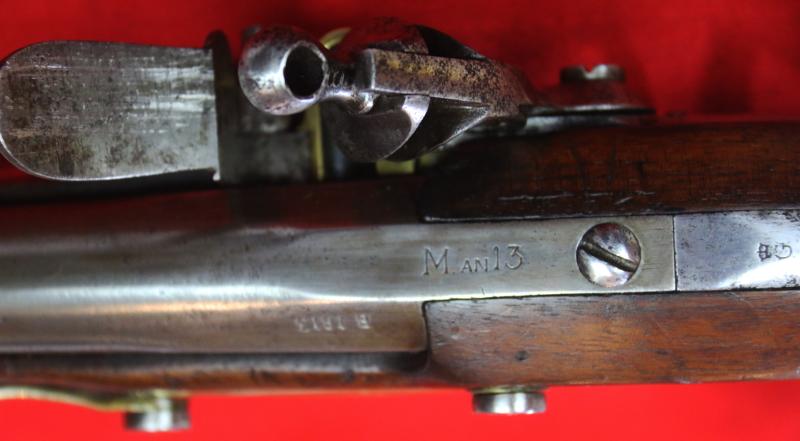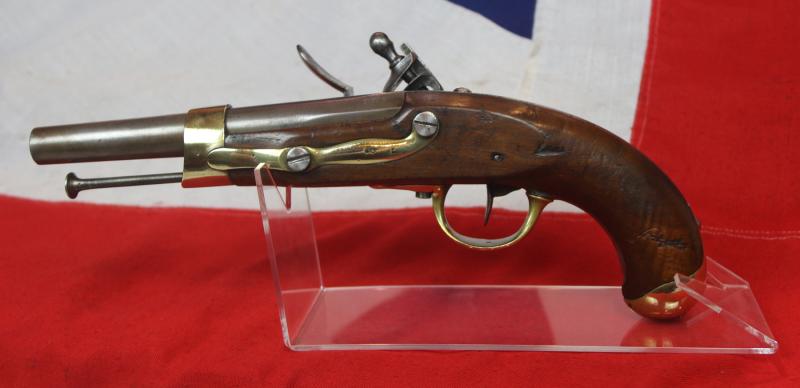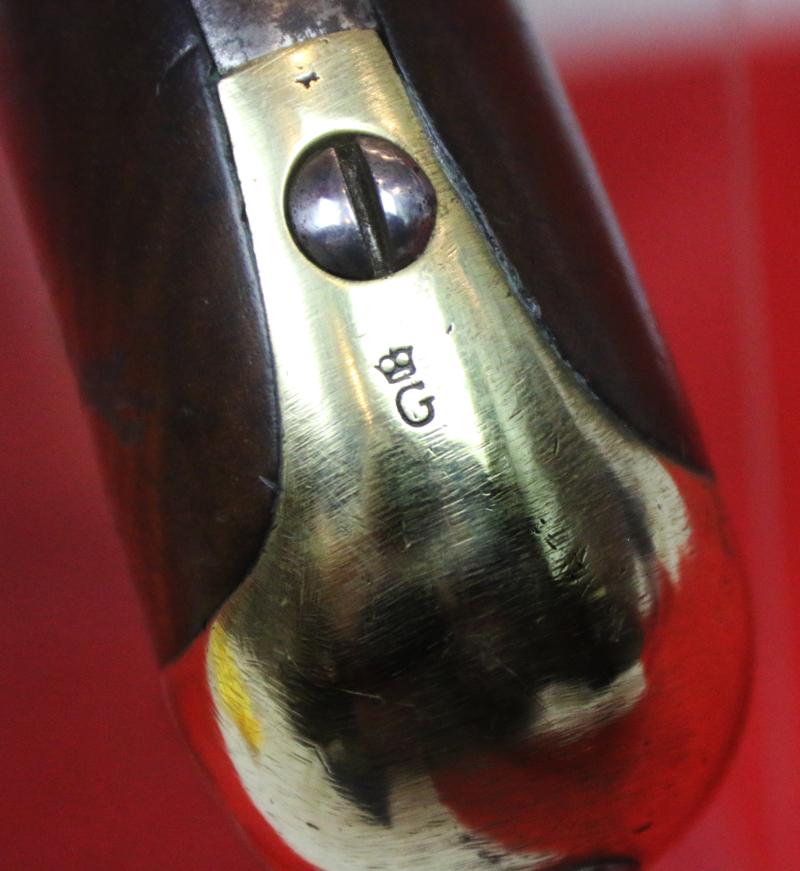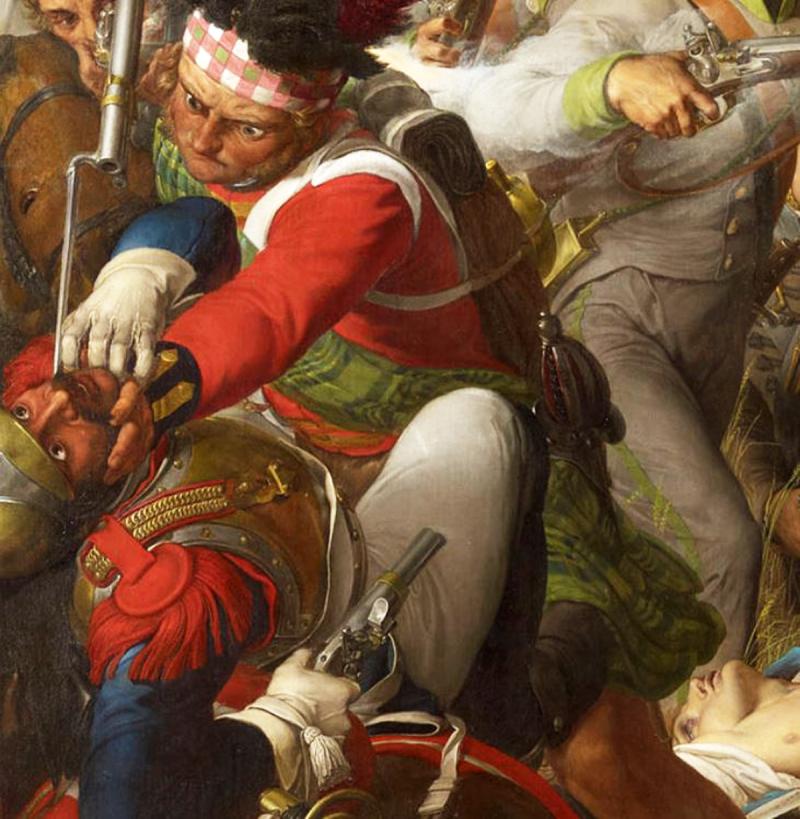An Original, French, Napoleonic Year 13 Modele, & Dated 1813 French Flintlock Line Cavalry Pistol, Mauberge Manufacture Imperial. Manufactured For Napoleon's Army To Replace All The Grande Armee Pistols Lost In the Retreat From Moscow
One of the flintlocks from a fabulous & large original collection of finest Imperial French swords and pistols we recently acquired, this one is one of a near identical pair we purchased, but each is being sold separate. Each part of this flintlock pistol bears the poincon stamp of Gouilloud, Napoleonic imperial arms inspector from 1804, lock made at the Maubeuge Manufacture Imperiale. Excellent condition overall with a tight and crisp spring action. A true museum grade original souvenir from the Napoleonic Wars
This flintlock pistol was made at the French Royal Arsenal at Mauberg {formerly the Imperial Arsenal} in 1813, before Napoleon's defeat in 1814 and exile to Elba, and his return in 1815. Thus this pistol was made and whereupon it was issued to the cuirassiers, that then very soon transferred their loyalty back to their old emperor, Napoleon upon his return from exile in Elba. It was used by the cuirassiers in the 100 Days War, culminating in Napoleon's final defeat at Quatre Bras and Waterloo by the Duke of Wellington, and this pistol being taken as war booty.
Used as a regimental issue sidearm, by and the very best French Napoleonic frontline cavalry, the carabineers, cuirassiers, chasseurs, dragoons and lancers, serving in Napoleon Bonaparte's army during the Napoleonic Wars. This is the pattern called the AN 13 {year 13} which represents the 13th year of French Ist Republic of 1792. The French Republican Calendar or French Revolutionary Calendar was a calendar proposed during the French Revolution, and used by the French government for about 12 years from late 1793. This is the pattern of pistol that would have first seen service in the Elite Imperial Guard Cuirassiers of Napoleon's great heavy cavalry regiments. The Cuirassiers Heavy Cavalry Regiments used the largest men in France, recruited to serve in the greatest and noblest cavalry France has ever had. They fought with distinction at their last great conflict at the Battle of Waterloo in 1815, and most of the Cuirassiers pistols now in England very likely came from that field of conflict, after the battle, as trophies of war. This pistol may well have been taken from a vanquished Cuirassier pistol that was drawn for combat on the field of battle. One can imagine this pistol lying freely, or, maybe, even still clasped in his cold desperate hand, or even under his fallen steed, at the field of conflict at Waterloo. Every warrior that has ever entered service for his country sought trophies. The Mycenae from a fallen Trojan, the Roman from a fallen Gaul, the GI from a fallen Japanese, the tradition stretches back thousands of years, and will continue as long as man serves his country in battle. In the 1st century AD the Roman Poet Decimus Iunius Iuvenalis Juvenal
wrote; "Man thirsts more for glory than virtue. The armour of an enemy, his broken helmet, the flag ripped from a conquered trireme, are treasures valued beyond all human riches. It is to obtain these tokens of glory that Generals, be they Roman, Greek or barbarian, brave a thousand perils
and endure a thousand exertions". A truly super Napoleonic pistol. The cuirassiers were the greatest of all France's cavalry, allowing only the strongest men of over 6 feet in height into it's ranks. The French Cuirassiers were at their very peak in 1815, and never again regained the wonder and glory that they truly deserved at that time. To face a regiment of, say, 600 charging steeds bearing down upon you mounted with armoured giants, brandishing the mightiest of swords that could pierce the strongest breast armour, much have been, quite simply, terrifying. Made in the period that Napoleon was Emperor and ruling most of Europe, it was used through the Napoleonic period from 1813, later in the the Royal restoration period, when Napoleon was imprisoned at Elba, and then during the War of the 100 days, culminating at Waterloo .
All Napoleon's heavy Cavalry Regiments fought at Waterloo, there were no reserve regiments, and all the Cuirassiers, without exception fought with their extraordinary resolve, bravery and determination. The Hundred Days started after Napoleon, separated from his wife and son, who had come under Austrian control, was cut off from the allowance guaranteed to him by the Treaty of Fontainebleau, and aware of rumours he was about to be banished to a remote island in the Atlantic Ocean, Napoleon escaped from Elba on 26 February 1815. He landed at Golfe-Juan on the French mainland, two days later. The French 5th Regiment was sent to intercept him and made contact just south of Grenoble on 7 March 1815. Napoleon approached the regiment alone, dismounted his horse and, when he was within gunshot range, shouted, "Here I am. Kill your
Emperor, if you wish." The soldiers responded with, "Vive L'Empereur!" and marched with Napoleon to Paris; Louis XVIII fled. On 13 March, the powers at the Congress of Vienna declared Napoleon an outlaw and four days later Great Britain, the Netherlands, Russia, Austria and Prussia bound themselves to put 150,000 men into the field to end his rule. Napoleon arrived in Paris on 20 March and governed for a period now called the Hundred Days. By the start of
June the armed forces available to him had reached 200,000 and he decided to go on the offensive to attempt to drive a wedge between the oncoming British and Prussian armies. The French Army of the North crossed the frontier into the United Kingdom of the Netherlands, in modern-day Belgium. Napoleon's forces fought the allies, led by Wellington and Gebhard Leberecht von Blücher, at the Battle of Waterloo on 18 June 1815. Wellington's army withstood repeated attacks by the French and drove them from the field while the Prussians arrived in force and broke through Napoleon's right flank. The French army left the battlefield in disorder, which allowed Coalition forces to enter France and restore Louis XVIII to the French throne. Off the port of Rochefort, Charente-Maritime, after consideration of an escape to the United States, Napoleon formally demanded political asylum from the British Captain Frederick Maitland on HMS Bellerophon on 15 July 1815. The pistol is in very nice condition overall.
Code: 25398



